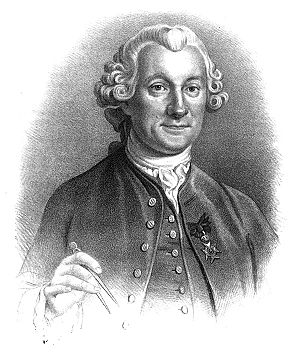Pehr Wilhelm Wargentin facts for kids
Pehr Wilhelm Wargentin (born in Sunne parish, Jämtlands län on September 11, 1717 – died in Stockholm on December 13, 1783) was a famous Swedish astronomer and demographer. A demographer is someone who studies human populations, like how many people are born or die.
Contents
Early Life and Education
Pehr Wargentin's father was a vicar named Wilhelm Wargentin. When Pehr was 12 years old, he saw a total lunar eclipse. This amazing event made him interested in Astronomy for the rest of his life.
He went to an elementary school called Frösö trivialskola. His teacher thought he was very smart. The teacher suggested he go straight to Uppsala University. However, Pehr's father wanted him to attend a secondary school first. So, Pehr went to the gymnasium in Härnösand.
Pehr found the school's lessons mostly about old languages and religion. He felt there wasn't enough science. Because of this, he did not finish his fourth year there.
In 1735, Wargentin started studying at the University of Uppsala. He was an excellent student. One of his teachers was Olof Hiorter, another important astronomer. Pehr earned his highest degree in the Faculty of Arts in 1743. He then became a special teacher in astronomy in 1746.
A Leader in Science
In 1749, Pehr Wargentin moved to Stockholm. He became the secretary of the Royal Swedish Academy of Sciences. This Academy had been started in 1739. Wargentin stayed in this important job until he died. He was the first secretary to serve for such a long time. Many people believe he helped the Academy become very successful during its "golden era."
Wargentin also became the first director of the Stockholm Observatory. This observatory was built by the Academy of Sciences and finished in 1753. In 1756, Wargentin married Christina Magdalena Raab. They had three daughters together.
In 1781, he was made an honorary member of the American Academy of Arts and Sciences. This showed that his work was recognized around the world.
Studying the Moons of Jupiter
Pehr Wargentin spent a lot of time studying the moons of the planet Jupiter. He published his first paper about this topic in 1741. It was in a scientific journal called the Acta of the Royal Society of Sciences in Uppsala. His detailed observations helped astronomers understand more about our solar system.
Focus on Population Studies
Later in his career, Wargentin's work changed. He started to focus more on demography. In 1736, the Swedish government decided that church leaders should keep records of all births and deaths in their areas.
The Royal Swedish Academy of Sciences then thought it would be good to study all this information for the whole country. Wargentin was chosen to lead this big task in 1754. He wrote many articles about population changes in Sweden. One important paper was called “Mortaliteten i Sverige, i anledning af Tabell-Verket.” This means "Mortality in Sweden, due to the Table Work."
Wargentin's Legacy
Pehr Wargentin's contributions to science are still remembered today. A crater on the Moon is named after him. Also, a secondary school in Östersund, Jämtland, called Wargentinsskolan, carries his name. This school has a connection to the one he attended on Frösön.


